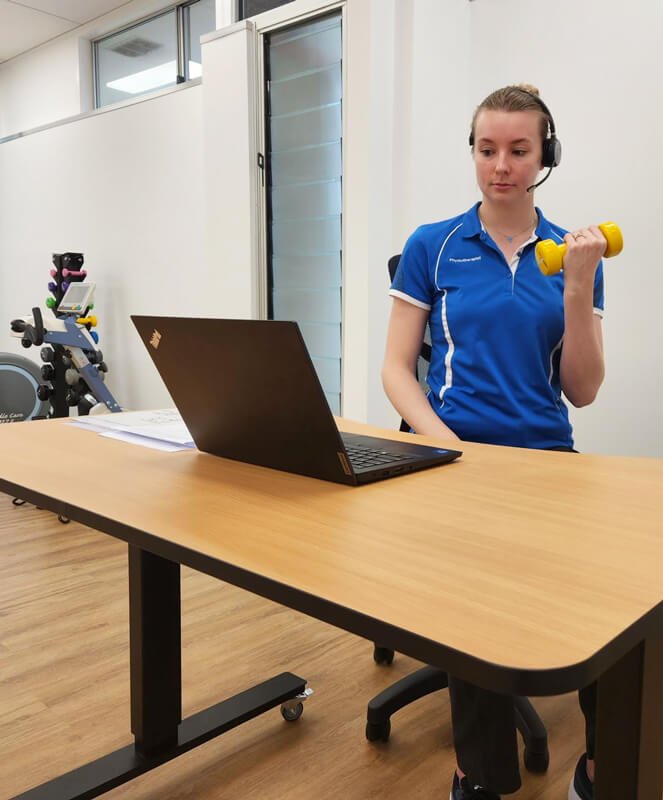For decades, physiotherapy was synonymous with a clinic visit, hands-on treatment tables, supervised exercises, and real-time feedback from your therapist. Then came high-speed internet, smartphones, and the global shift towards remote healthcare.
Does Online Physiotherapy Really Work? Here’s When It Gets Great Results
For decades, physiotherapy was synonymous with a clinic visit, hands-on treatment tables, supervised exercises, and real-time feedback from your therapist.
On this page
- Understanding Online Physiotherapy
- Why Online Physiotherapy Emerged
- The Evidence: Does Online Physiotherapy Work?
- When Online Physiotherapy Gets Great Results
- Advantages of Online Physiotherapy
- Limitations of Online Physiotherapy
- How Online Physiotherapy Sessions Typically Work
- Real-World Success Stories
- DMPhysios: Bringing Expert Care to Your Home
- Conclusion


Introduction: Fitness Culture’s Blind Spot
Then came high-speed internet, smartphones, and the global shift towards remote healthcare. Suddenly, the possibility of online physiotherapy, also called tele-physiotherapy, tele-rehabilitation, or virtual physiotherapy became not only feasible but, in some cases, essential..
But does online physiotherapy actually work? And more importantly, when does it deliver great results? In this article, we’ll dive deep into what online physiotherapy is, how it’s delivered, its benefits and limitations, and the situations where it shines. We’ll also explore how clinics like DMPhysios in Noida integrate virtual care into their patient-centered rehabilitation model to support better outcomes.
Understanding Online Physiotherapy
Online physiotherapy involves delivering assessment, education, exercise programs, and even parts of manual therapy instruction through secure video calls, apps, or digital platforms. Instead of travelling to a clinic, you meet your physiotherapist virtually. You might use your phone camera to show your movement patterns, upload medical reports, or follow along with video-guided exercises.
In most cases, online physiotherapy focuses on:
- Assessment and monitoring of injuries, movement patterns, or post-surgical recovery.
- Guided exercise prescription, progression, and correction.
- Education on pain management, ergonomics, or injury prevention.
- Lifestyle modification and home program design.
- Accountability check-ins to ensure consistency.
This model mirrors in-person physiotherapy’s core principle: empowering the patient with knowledge and exercises to recover. While hands-on manual therapy is limited online, the majority of physiotherapy interventions worldwide are exercise and education-based which translates well to a digital setting.
Why Online Physiotherapy Emerged
The rise of online physiotherapy wasn’t purely a matter of convenience. Several factors accelerated its adoption:
- Pandemic-driven remote care forced clinics to find ways to continue serving patients safely.
- Growing tech literacy made video calls and fitness apps normal for all age groups.
- Improved wearable and mobile cameras allow more accurate movement analysis remotely.
- Demand for flexible care from busy professionals, parents, or people living in remote areas.
Clinics such as DMPhysios in Noida adapted quickly, developing secure systems to connect with patients who couldn’t attend in person. For many people, these virtual sessions were a lifeline, keeping their recovery on track despite lockdowns, travel limitations, or health concerns.
The Evidence: Does Online Physiotherapy Work?
The short answer is yes – when implemented correctly and for the right conditions. Numerous peer-reviewed studies and systematic reviews have evaluated tele-rehabilitation. Key findings include:
- Musculoskeletal conditions: Research shows online exercise programs are as effective as in-person care for many injuries like low back pain, shoulder impingement, knee osteoarthritis, and post-operative rehab.
- Post-surgical recovery: Virtual physiotherapy can improve adherence to home exercise programs after surgeries such as total knee replacement or rotator cuff repair, especially when combined with app-based reminders.
- Chronic conditions: Telehealth interventions improve pain, function, and quality of life in chronic low back pain and arthritis.
- Cost-effectiveness: Online care reduces travel time and costs for both patients and clinics.
Importantly, outcomes depend on program quality, therapist experience, patient engagement, and the suitability of the condition for remote management. DMPhysios, for instance, uses evidence-based exercise protocols tailored to each patient, combined with regular virtual check-ins to track progress and make adjustments, a model shown to enhance adherence and results.
When Online Physiotherapy Gets Great Results
Not every injury or condition is suited for online care. However, there are clear scenarios where it performs exceptionally well.
• Early Intervention for Common Musculoskeletal Issues
If you’re experiencing non-acute pain in your back, neck, or shoulder, early online physiotherapy can help you start exercises, correct posture, and prevent the issue from worsening. These conditions are primarily managed through education and exercise anyway, making virtual care ideal.
• Post-Surgical or Post-Injury Exercise Progression
Once your surgeon clears you for movement and your wound is stable, much of the rehab involves graded exercises, range of motion work, and strengthening – all of which can be guided online. Clinics like DMPhysios design progressive programs and use live video to ensure you’re performing each exercise correctly.
• People Living in Remote or Underserved Areas
If you live far from a quality physiotherapy clinic, online sessions can bring expert care to your home. Instead of settling for generic exercise videos, you get personalized guidance from a licensed professional.
• Chronic Pain and Long-Term Conditions
Patients with chronic low back pain, fibromyalgia, or arthritis often need ongoing support rather than frequent manual therapy. Virtual check-ins and coaching can reinforce self-management strategies and keep you accountable.
• Workplace Ergonomics and Preventive Care
For desk workers struggling with posture-related neck or shoulder pain, online physiotherapy excels. A therapist can virtually “audit” your workstation, suggest modifications, and teach micro-break exercises.
• Follow-Up and Progress Reviews
Even patients who begin with in-person treatment may transition to online sessions for progress reviews. This hybrid model, which DMPhysios frequently uses, maximizes convenience without sacrificing quality.
Advantages of Online Physiotherapy
Online physiotherapy offers more than just convenience. Its benefits include:
- Flexibility: Fit sessions into your schedule without travel.
- Access to specialists: Work with experts outside your city or country.
- Improved adherence: Apps and digital reminders keep you consistent.
- Family involvement: Caregivers can attend sessions to learn support techniques.
- Reduced barriers: Mobility issues, childcare, or transportation no longer block your rehab.
For clinics like DMPhysios, this approach also means maintaining continuity of care. Patients who start in person can seamlessly shift online if they travel or face scheduling conflicts, keeping their recovery uninterrupted.
Limitations of Online Physiotherapy
Despite its strengths, online physiotherapy has limitations that must be acknowledged:
- No direct manual therapy: Techniques like joint mobilizations, manipulations, or soft tissue massage require physical contact.
- Assessment constraints: Certain tests, such as ligament stability tests, are harder to perform accurately online.
- Technology requirements: Reliable internet and devices with good cameras are essential.
- Self-motivation needed: Patients must actively participate and follow home programs.
Ethical and safety considerations also apply. Reputable clinics screen patients carefully to determine whether online care is appropriate or whether an in-person evaluation is necessary first. DMPhysios, for instance, begins every virtual program with a detailed intake questionnaire and movement assessment to identify red flags.
Hybrid Care: The Best of Both Worlds
For many patients, a combination of in-person and online physiotherapy is ideal. Initial hands-on sessions for assessment, manual therapy, or teaching exercises may transition to virtual check-ins once you’re confident performing the exercises independently.
This hybrid model:
- Reduces clinic visits while keeping you on track.
- Provides flexibility for travel or schedule changes.
- Ensures safety and progress monitoring.
DMPhysios has found that patients using this blended approach often report higher satisfaction, as they feel supported yet empowered to manage their recovery at home.
How Online Physiotherapy Sessions Typically Work
If you’ve never tried online physiotherapy, you might wonder what to expect. A typical session at a clinic like DMPhysios looks like this:
- Pre-Session Intake: You complete an online form detailing your injury, pain, goals, and medical history.
- Video Call Assessment: Your physiotherapist observes your posture, movements, and any functional tasks. You may be asked to perform specific tests.
- Diagnosis and Education: The therapist explains your condition, contributing factors, and the treatment plan.
- Exercise Demonstration: You’re shown how to perform exercises correctly. The therapist watches you and gives real-time feedback.
- Home Program Delivery: You receive a digital program with videos, reps, sets, and progression guidelines.
- Follow-Up and Progression: Regular online reviews adjust your plan as you improve.
With good lighting, enough space, and a stable camera setup, these sessions can feel surprisingly interactive.
Tips for Getting the Most Out of Online Physiotherapy
If you’re considering online physiotherapy, these tips can help maximize your results:
- Choose a reputable provider. Look for licensed physiotherapists experienced in virtual care.
- Prepare your space. Clear enough room to move, set up good lighting, and position your camera so your whole body is visible.
- Have any equipment ready. Resistance bands, mats, or small weights may be recommended.
- Ask questions. Treat the session like an in-person visit – clarify doubts and ensure you understand each exercise.
- Stay consistent. Follow the prescribed home program and attend scheduled check-ins.
Real-World Success Stories
While patient confidentiality limits the details, many clinics have documented significant successes with online physiotherapy. Examples include:
- A middle-aged runner recovering from a knee injury who returned to pain-free jogging after eight weeks of virtual sessions.
- A desk worker with chronic neck pain who improved posture and reduced headaches through online ergonomic coaching and exercises.
- A post-operative shoulder patient who, after initial in-person sessions, transitioned to online rehab while travelling and still achieved full range of motion.
At DMPhysios, therapists have seen similar outcomes. Patients often report that the convenience of online care actually improves their adherence, leading to better long-term results than sporadic in-clinic visits.
The Future of Physiotherapy Is Hybrid
As digital health tools evolve from wearable motion sensors to AI-assisted exercise tracking, online physiotherapy will only become more effective. Yet the human connection remains essential. The best results come from combining expert clinical judgment, personalized exercise plans, and ongoing support.
For patients, this means more options. Whether you prefer face-to-face sessions, online coaching, or a mix of both, modern physiotherapy can meet you where you are.
DMPhysios: Bringing Expert Care to Your Home
One of the reasons online physiotherapy has taken off so successfully is that established clinics have put robust systems in place. DMPhysios, a leading physiotherapy and rehabilitation clinic in Noida, is a good example. Known for its patient-centred approach to spine, sports, and post-surgical conditions, DMPhysios has built a secure platform for online physiotherapy sessions so patients don’t have to pause their recovery if they can’t come in person.
Through video consultations, detailed digital exercise plans, and regular follow-ups, DMPhysios’ team helps patients:
- Get assessed and receive a clear diagnosis remotely
- Learn and practice exercises under live guidance
- Progress their rehab safely between in-clinic visits
- Stay accountable even when travelling or busy
This hybrid model lets patients switch smoothly between in-person and virtual care, maintaining continuity and results.
Conclusion
So, does online physiotherapy really work? Absolutely, when it’s done thoughtfully, for the right conditions, and with an engaged therapist-patient partnership. It excels at education, exercise progression, and long-term support, especially for musculoskeletal issues, chronic pain, or post-operative rehab.
Clinics like DMPhysios show how blending technology with patient-centred care can extend high-quality rehabilitation beyond the clinic walls. Their online physiotherapy sessions give patients flexible, expert-led treatment no matter where they are, without sacrificing the quality of in-person care.
If you’re considering physiotherapy but worried about time, travel, or access, an online consultation could be your first step toward recovery. Look for a provider who tailors sessions to your goals, offers clear guidance, and maintains open communication. The result is more than convenience – it’s a pathway to active participation in your own healing.








